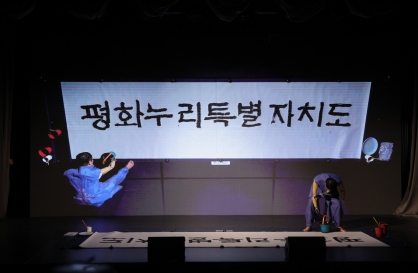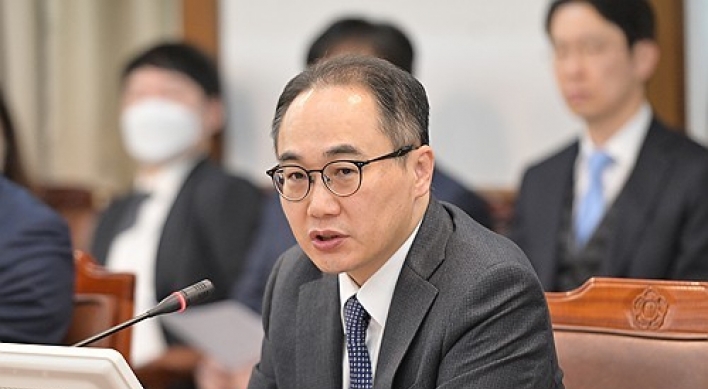The special poll in Seoul on Wednesday is the culmination of a bitter and bizarre political fight that has little to do with what is best for children and lots to do with the future direction of Korea’s elections.
Opposition Democratic Party members, who control the Seoul Metropolitan Council and the city education office, passed a bill in December 2010 that will provide free lunches to all students, regardless of income, through middle school.
Seoul Mayor Oh Se-Hoon, a member of the ruling Grand National Party, strongly opposes the bill, arguing that wealthy students don’t need free meals and the program will cost too much money. He has even staked his political future on the outcome of this vote.
This liberal vs. conservative battle will climax Wednesday in a historic referendum -- the first of its kind in Seoul. Voters will be asked to choose to provide universal free lunch or to provide free lunch to students in the bottom 50 percent income bracket.
If Seoul voters pass either of the two options on the ballot, I hope the city government will put politics aside and effectively implement the program. I also hope Seoul does not follow the path of the United States.
The United States has provided school lunches -- including free and reduced price meals for low-income children -- for over a half century. The primary purpose of the program has been to support the health of students and thereby improve their academic performance. The federal program also became a way to support the country’s agriculture industry through the purchase of milk, cheeses and grains.
But as costs and usage increased, the school lunch program faced the challenge of buying huge quantities of food at low prices, which reduced quality. Because of low cost and easy availability, corn-based products and heavily-processed food became a staple of school lunches -- and the American diet.
American children were overfed and undernourished, causing the obesity rate among children to skyrocket. Between 1980 and 2008, the prevalence of obesity among children ages 6 to 11 years jumped from 6.5 percent to 19.6 percent, and the prevalence of obesity among adolescents ages 12 to 19 years rose from 5 percent to 18.1 percent, according to the Centers for Disease Control. The explosion in obesity has been linked to an increase in childhood diabetes and other chronic health problems.
In response to the obesity epidemic, federal, state and local governments and school districts have been trying a variety of initiatives to improve the quality of school lunches and breakfasts. These efforts include reducing the use of processed food, increasing the use of locally-grown produce, food made with whole grains and dishes made in school kitchens rather than reheated from freezer bags or boxes.
The transition has been slow and difficult because it requires a major cultural shift and it costs more money. It will take many years to halt the obesity epidemic. Change is slow. My daughters’ school still serves funnel cake for breakfast and cheese sticks for lunch.
South Korea is in a much better position on this issue. While obesity rates have increased among children on the peninsula, Korean children are still generally healthier than American children. It is no surprise that school lunches are much healthier in Korea. Korean lunches typically consist of rice, soup, a protein that is either meat or tofu and vegetables or fruit. These foods are minimally processed and generally low in fat.
The South Korean government has also launched programs to improve children’s health by reducing sugar and fat in children’s snacks, regulating fast-food advertising and even creating junk-food-free zones around schools. These are all smart approaches to keeping children healthy -- and worth the public investment. Combating an obesity epidemic is much more costly and difficult than keeping our diets nutritious and healthy.
We will know soon how Seoul residents feel about the issue -- or at least about the politics that has dominated this debate. The politics has been so loud that few voters really know the pertinent facts necessary to make an informed decision. Will universal free lunch improve all students’ academic performance? Is it worth it to provide free lunch for all kids to avoid the stigma of welfare programs? I can think of worse ways to spend taxpayer money. But if the cost of providing free lunch will result in poorer quality of food, all children will be negatively affected. And that would be more shameful than this political circus.
By Myung Oak Kim
Myung Oak Kim is a freelance writer in Colorado and co-author of “The New Korea: An Inside Look into South Korea’s Economic Rise” (AMACOM, 2010). She worked as a newspaper reporter for more than 15 years, writing about childhood poverty, education and anti-hunger programs. -- Ed.
Opposition Democratic Party members, who control the Seoul Metropolitan Council and the city education office, passed a bill in December 2010 that will provide free lunches to all students, regardless of income, through middle school.
Seoul Mayor Oh Se-Hoon, a member of the ruling Grand National Party, strongly opposes the bill, arguing that wealthy students don’t need free meals and the program will cost too much money. He has even staked his political future on the outcome of this vote.
This liberal vs. conservative battle will climax Wednesday in a historic referendum -- the first of its kind in Seoul. Voters will be asked to choose to provide universal free lunch or to provide free lunch to students in the bottom 50 percent income bracket.
If Seoul voters pass either of the two options on the ballot, I hope the city government will put politics aside and effectively implement the program. I also hope Seoul does not follow the path of the United States.
The United States has provided school lunches -- including free and reduced price meals for low-income children -- for over a half century. The primary purpose of the program has been to support the health of students and thereby improve their academic performance. The federal program also became a way to support the country’s agriculture industry through the purchase of milk, cheeses and grains.
But as costs and usage increased, the school lunch program faced the challenge of buying huge quantities of food at low prices, which reduced quality. Because of low cost and easy availability, corn-based products and heavily-processed food became a staple of school lunches -- and the American diet.
American children were overfed and undernourished, causing the obesity rate among children to skyrocket. Between 1980 and 2008, the prevalence of obesity among children ages 6 to 11 years jumped from 6.5 percent to 19.6 percent, and the prevalence of obesity among adolescents ages 12 to 19 years rose from 5 percent to 18.1 percent, according to the Centers for Disease Control. The explosion in obesity has been linked to an increase in childhood diabetes and other chronic health problems.
In response to the obesity epidemic, federal, state and local governments and school districts have been trying a variety of initiatives to improve the quality of school lunches and breakfasts. These efforts include reducing the use of processed food, increasing the use of locally-grown produce, food made with whole grains and dishes made in school kitchens rather than reheated from freezer bags or boxes.
The transition has been slow and difficult because it requires a major cultural shift and it costs more money. It will take many years to halt the obesity epidemic. Change is slow. My daughters’ school still serves funnel cake for breakfast and cheese sticks for lunch.
South Korea is in a much better position on this issue. While obesity rates have increased among children on the peninsula, Korean children are still generally healthier than American children. It is no surprise that school lunches are much healthier in Korea. Korean lunches typically consist of rice, soup, a protein that is either meat or tofu and vegetables or fruit. These foods are minimally processed and generally low in fat.
The South Korean government has also launched programs to improve children’s health by reducing sugar and fat in children’s snacks, regulating fast-food advertising and even creating junk-food-free zones around schools. These are all smart approaches to keeping children healthy -- and worth the public investment. Combating an obesity epidemic is much more costly and difficult than keeping our diets nutritious and healthy.
We will know soon how Seoul residents feel about the issue -- or at least about the politics that has dominated this debate. The politics has been so loud that few voters really know the pertinent facts necessary to make an informed decision. Will universal free lunch improve all students’ academic performance? Is it worth it to provide free lunch for all kids to avoid the stigma of welfare programs? I can think of worse ways to spend taxpayer money. But if the cost of providing free lunch will result in poorer quality of food, all children will be negatively affected. And that would be more shameful than this political circus.
By Myung Oak Kim
Myung Oak Kim is a freelance writer in Colorado and co-author of “The New Korea: An Inside Look into South Korea’s Economic Rise” (AMACOM, 2010). She worked as a newspaper reporter for more than 15 years, writing about childhood poverty, education and anti-hunger programs. -- Ed.





![[Graphic News] Number of coffee franchises in S. Korea rises 13%](http://res.heraldm.com/phpwas/restmb_idxmake.php?idx=644&simg=/content/image/2024/05/02/20240502050817_0.gif&u=)




![[Robert J. Fouser] AI changes rationale for learning languages](http://res.heraldm.com/phpwas/restmb_idxmake.php?idx=644&simg=/content/image/2024/05/02/20240502050811_0.jpg&u=)
![[Today’s K-pop] Stray Kids go gold in US with ‘Maniac’](http://res.heraldm.com/phpwas/restmb_idxmake.php?idx=644&simg=/content/image/2024/05/02/20240502050771_0.jpg&u=)





![[Eye Interview] 'If you live to 100, you might as well be happy,' says 88-year-old bestselling essayist](http://res.heraldm.com/phpwas/restmb_idxmake.php?idx=652&simg=/content/image/2024/05/03/20240503050674_0.jpg&u=)
